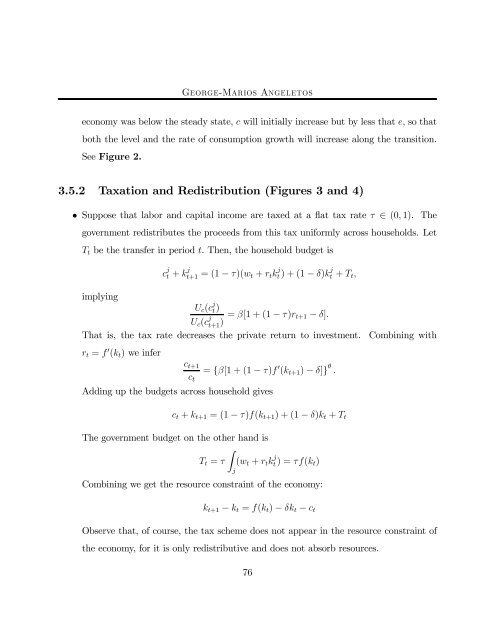14.451 Lecture Notes Economic Growth
14.451 Lecture Notes Economic Growth
14.451 Lecture Notes Economic Growth
Create successful ePaper yourself
Turn your PDF publications into a flip-book with our unique Google optimized e-Paper software.
George-Marios Angeletos<br />
economy was below the steady state, c will initially increase but by less that e, so that<br />
both the level and the rate of consumption growth will increase along the transition.<br />
See Figure 2.<br />
3.5.2 Taxation and Redistribution (Figures 3 and 4)<br />
• Suppose that labor and capital income are taxed at a flat tax rate τ ∈ (0, 1). The<br />
government redistributes the proceeds from this tax uniformly across households. Let<br />
Tt be the transfer in period t. Then, the household budget is<br />
implying<br />
c j<br />
t + k j<br />
t+1 =(1− τ)(wt + rtk j<br />
t )+(1− δ)k j<br />
t + Tt,<br />
Uc(c j<br />
t)<br />
Uc(c j<br />
t+1) = β[1 + (1 − τ)rt+1 − δ].<br />
That is, the tax rate decreases the private return to investment. Combining with<br />
rt = f 0 (kt) we infer<br />
ct+1<br />
ct<br />
= {β[1 + (1 − τ)f 0 (kt+1) − δ]} θ .<br />
Adding up the budgets across household gives<br />
ct + kt+1 =(1− τ)f(kt+1)+(1− δ)kt + Tt<br />
The government budget on the other hand is<br />
Z<br />
Tt = τ<br />
(wt + rtk<br />
j<br />
j<br />
t )=τf(kt)<br />
Combiningwegettheresourceconstraintoftheeconomy:<br />
kt+1 − kt = f(kt) − δkt − ct<br />
Observe that, of course, the tax scheme does not appear in the resource constraint of<br />
the economy, for it is only redistributive and does not absorb resources.<br />
76

















